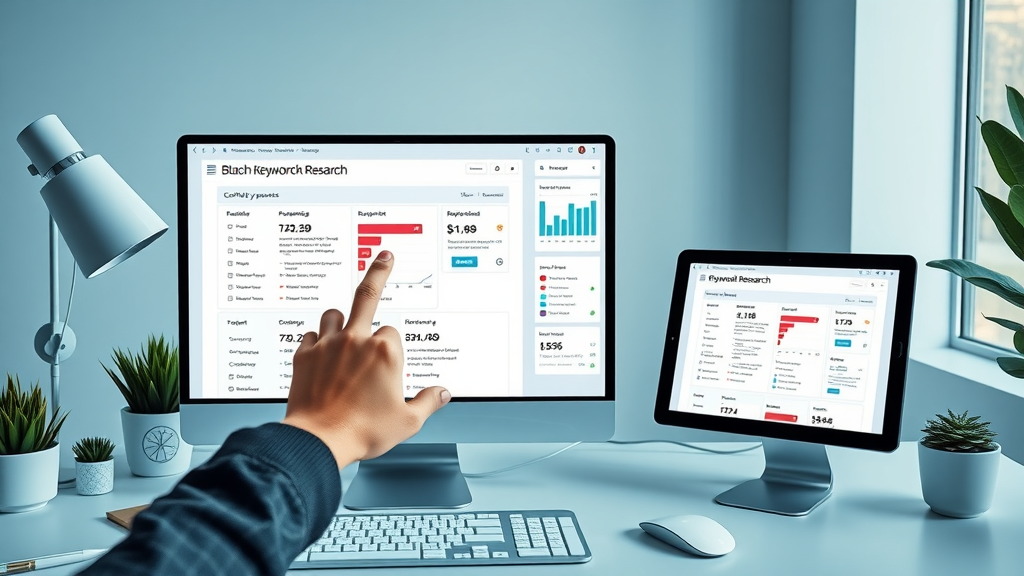Did you know that 46% of all Google searches are seeking local information? Small businesses that invest in strategic SEO will see 2-3x more organic leads than those relying on traditional advertising alone.
SEO for Small Businesses: Why It’s a Game-Changer for Organic Traffic

- Discover how SEO for small businesses directly boosts organic traffic and visibility
- Explore practical examples of small business seo success stories
- Understand the role of local seo in supporting small business growth
SEO for small businesses isn’t just a passing trend—it’s the new lifeblood of digital visibility. When a customer searches for a product or service in your area, effective local SEO ensures your small business rises to the top of search engine results. This shift has empowered many local business owners to outrank larger competitors and connect directly with nearby potential customers, driving both walk-in visits and online inquiries. Practical case studies show everything from coffee shops to dental practices doubling their organic traffic simply by implementing targeted business SEO tactics. Instead of pouring funds into costly ads, these businesses attract sustainable leads and forge loyal local clientele, creating a resilient foundation for long-term growth.
Local SEO also delivers a distinct advantage for small businesses by making their presence known exactly when users are looking for their services, whether they are at home on a laptop or searching from their smartphones just blocks away. For example, a bakery updating its Google Business Profile and optimizing its website’s content with neighborhood keywords can suddenly appear in both Google Search and Google Maps for “best chocolate croissants near me.” This direct path from searcher to store is the essence of why SEO for small businesses is a game-changer—it transforms passive browsers into loyal, recurring customers.
What You'll Gain: Mastering SEO for Small Businesses
- Gain step-by-step strategies for implementing business seo
- Learn effective local seo tactics for small businesses
- Discover actionable tips on keyword research and search engine optimization
- Get access to real-life small business seo examples
By the end of this comprehensive guide, you’ll be equipped with proven business SEO strategies, from foundational knowledge to hands-on optimization tips. You’ll learn how to research high-value keywords, create engaging content that ranks, and set up your Google Business Profile for peak performance in local search. Plus, with powerful insights into analytics and common pitfalls, you’ll gain the tools to transform your small business’s web presence and see measurable results in organic traffic.
How Local SEO Transforms Small Businesses and Local Search Results
The Power of Local SEO for Small Businesses

- What is local seo and why it matters to small businesses
- How local search drives walk-in and online traffic
- Integrating local business strategies and optimizing Google Business Profile
Local SEO is the engine that powers the connection between small businesses and their communities. By optimizing a local business presence online, you ensure your company shows up in crucial local search queries—think “best accountant near me” or “pet grooming downtown.” This isn’t just about appearing in search engine results; it’s about occupying space where your customers are already seeking answers. For small businesses, appearing in Google’s local pack or on Google Maps means a surge in both digital and foot traffic, all made possible by strategic optimization efforts.
The role of local search extends beyond visibility—it drives targeted, motivated traffic right to your doorstep. People searching locally are typically ready to act, making their visits far more likely to convert into real revenue. Consider salons that leverage Google Business Profiles to showcase appointment slots or restaurants displaying live menus; these features all ride the tide of effective local SEO. By keeping your business profile up to date, earning positive reviews, and consistently posting fresh content, your business not only stands out but becomes the trusted choice for your neighborhood.
Integrating local SEO also means weaving your small business into community discussions, local directories, and event pages. These tactics extend your digital footprint and build authentic trust with potential customers . Harnessing local backlinks and partnering with other nearby businesses enhances credibility and raises your likelihood of being featured in relevant search engine results, cementing your status as a go-to in the area.
Building a Winning SEO Strategy for Small Business Owners
Defining Your SEO Strategy: Small Business SEO Foundations

- Key elements of an effective small business seo plan
- Choosing the right keywords through thorough keyword research
- Aligning seo strategy with business goals
Building a strong seo strategy begins with clarity: understanding your business goals, your audience, and the competitive landscape. For small businesses, an effective plan starts with thorough keyword research to discover what your ideal customers are searching for. This process uncovers high-intent search phrases, such as “eco-friendly cleaning services in Brooklyn” or “affordable family lawyers near me,” that your potential customers use daily. By targeting these specific keywords, small businesses can build content and pages designed to capture valuable traffic.
Aligning your business SEO efforts to your overall growth goals is critical. Focus your content and optimization initiatives on the products or services delivering the most value to your business. Regularly review website analytics and monitor which keywords drive leads and conversions. Effective search engine optimization is not static—it’s an ongoing process of adapting and refining your approach as your business grows, consumer trends shift, and new opportunities emerge.
Remember, successful small business SEO is about more than just rankings; it’s about turning those rankings into real revenue. By being intentional with your strategy, you’ll outperform competitors and consistently attract the right traffic for your business.
The 3 C’s of SEO for Small Businesses: Content, Code, and Credibility
- Optimizing website code for search engines
- Building authority and trust online
- Publishing high-quality content that attracts organic traffic
The foundation of SEO for small businesses rests on three main pillars: Content , Code , and Credibility —the 3 C’s. Quality content is the cornerstone: blog posts, service pages, and FAQs optimized to answer real user questions and deliver value. Next is Code; your website’s structure should be technically sound, ensuring fast load times, responsive design, clear navigation, optimized meta descriptions , and an error-free experience for both users and search engine crawlers.
The third pillar, Credibility, is earned through authority signals like backlinks from reputable sources, glowing customer reviews, and an active social media presence. Search engines use these indicators to determine which businesses are trustworthy and deserving of higher rankings. For small business owners , investing time in these three C’s pays long-term dividends, building a sustainable flow of organic traffic and strengthening your business profile within the community.
Setting Up and Optimizing Your Google Business Profile
Claim, Verify, and Enhance Your Google Business Profile
- Step-by-step to claim and verify your business profile
- How to update and optimize your google business information
- Leverage your profile for better performance on local search & google search

Your Google Business Profile is a crucial asset for any small business. Begin by claiming and verifying your listing through Google—this step authenticates your business and gives you control over how it appears on Google Search and Google Maps . Once verified, update your business name, address, phone number, business category, and hours of operation. These details must be accurate and consistent across the web for maximum credibility.
Optimizing your Google Business information means adding compelling business descriptions, uploading bright, inviting photos, and encouraging customers to leave honest reviews. Utilize the Posts section to share promotions, events, or behind-the-scenes stories, keeping your profile fresh and engaging. Regularly respond to customer questions and monitor your business profile’s analytics to understand how searchers interact with your information. These habits transform your listing into a powerful lead-generating tool, making sure your small business stands out in both local and organic search results.
Utilizing Google Search Console for Small Business SEO Insights
- Setting up google search console for your small business
- Using search console tools to monitor search engine optimization progress
- Fixing website issues for improved search engine visibility
Google Search Console is your go-to dashboard for gaining insight into your website’s search performance. Set it up by verifying your domain, then explore reports detailing which keywords drive the most clicks, how your pages rank, and where you can improve. Search Console helps you monitor technical SEO issues, such as crawl errors, mobile usability, and security concerns. Swiftly resolving these problems boosts your site’s visibility and ensures it’s primed for search engines to index and rank your content.
Regularly use Search Console to identify which search queries your site appears for, how your blog topics perform, and where opportunities exist for further keyword research . The platform’s tools assist small business owners in tracking performance trends and making informed decisions on where to focus optimization efforts next. These proactive habits will safeguard your site’s visibility and fuel your ongoing business SEO success.
Crucial Keyword Research Techniques for Small Businesses
Effective Keyword Research for Maximum Small Business SEO Impact
- Identifying high-value keywords for your niche
- How keyword research fuels effective seo strategy
- Free and paid tools for small business owners
At the heart of every impactful SEO strategy is keyword research . Begin by brainstorming a list of query types your target customers might use—questions, product names, and location-specific keywords. Free tools like Google Keyword Planner and Ubersuggest, or paid platforms like Ahrefs, Moz, and SEMrush, help you dive deeper. Analyze the monthly search volume, ranking difficulty, and intent behind each phrase. Select keywords that balance competition and traffic potential, targeting those most likely to result in leads or sales.
| Tool Name | Free/Paid | Key Features | Ideal For |
|---|---|---|---|
| Google Keyword Planner | Free | Basic keyword research, volume estimates | Beginners, budget-focused |
| Ubersuggest | Freemium | Keyword ideas, traffic estimates, content suggestions | Small business owners, DIYers |
| Ahrefs | Paid | Comprehensive keyword & competitor insights | Advanced strategy, agencies |
| Moz Pro | Paid | Keyword difficulty, SERP insights, tracking | Ongoing SEO campaigns |
| SEMrush | Paid | Keyword analytics, rank tracking, competitive analysis | Multi-channel strategies |

Incorporate high-opportunity keywords into your site’s page titles, meta descriptions, headers, and naturally within your content. Continuously monitor keyword performance and adjust your keyword plan to adapt to search trends. The right approach to keyword research will set your small business apart, driving qualified organic search traffic and rapid growth online.
Crafting Quality Content and Building Local Authority through Business SEO
Creating Relevant and Quality Content for Your Small Business
- Brainstorming content ideas for target search engine users
- Why quality content is the cornerstone of successful engine optimization
- Examples of effective blog topics for small businesses

Quality content is the heart of engine optimization for small businesses. Start by identifying your customer’s pain points and interests—think frequently asked questions, tips, how-to guides, and stories that demonstrate your expertise. Consistently publishing relevant, original, and engaging blog posts builds trust with both users and search engines. Adding real value with each article, customers come to see your business as a reliable local resource, making them far more likely to choose you over competitors.
Consider these effective blog topics: “5 Signs Your Roof Needs Repair,” “What to Expect from a Free Dental Consultation,” or “How to Support Local Artists in [Your City].” Tailoring content to local interests boosts your local search rankings, places your business in helpful answer boxes, and positions your site as an authority. Consistency and quality are the golden rules here—fresh content signals to search engines that your business is active and should be ranked highly in relevant search engine results.
Winning Local Links and Building Business SEO Trust
- How local backlinks help boost search engine rankings
- Collaborating with other local businesses for backlinks
- Promoting your content through business profiles and local organizations

Local backlinks are vital for boosting search engine trust and rankings. When other reputable local organizations link to your site, search engines view your business as a credible authority within your area. Reach out to local bloggers, news outlets, Chambers of Commerce, or charities for natural backlink opportunities. Hosting joint events or offering expert quotes can earn valuable mentions and links from partners whose audiences overlap yours.
Amplify your reach by promoting blog content or announcements on local business profiles, directories, and social media pages. Encourage satisfied clients to share your posts or leave reviews with backlinks to your website. Participating in interviews, podcasts, or online events further enhances your business SEO footprint, while cultivating connections that foster goodwill and digital visibility. Small businesses that prioritize quality content and link-building strategies consistently outperform competitors and climb the search engine results page.
Boosting Small Business Visibility on Search Engines with Technical SEO
Technical SEO Fundamentals for Small Businesses
- Ensuring your website is mobile-friendly and fast
- Optimizing site structure for search engine crawlers
- Fixing common technical seo errors for small business owners

Technical SEO is the nuts and bolts behind a successful online presence. First, ensure your website is fully mobile-friendly, as the majority of search engines now prioritize mobile experiences in their ranking algorithms. Optimize speed by compressing images, leveraging browser caching, and minimizing unnecessary code. A slow-loading site not only frustrates users but also signals to search engines that your content may not offer the best experience.
Structure your website so that navigation is intuitive, with a clear hierarchy that guides both users and search engine crawlers . Use descriptive URLs, clean headings, and internal links that help connect your pages. Don’t overlook important elements like meta titles and meta descriptions, as they directly influence your visibility and click-through rates from search engine results. Regularly audit your site for common technical SEO issues—broken links, duplicate titles, and missing alt text—to maintain peak performance and search rankings.
Analyzing and Measuring Your SEO for Small Businesses Success
Using Analytics Tools to Track Business SEO Efforts
- Key search engine optimization metrics for small businesses
- Leveraging Google Analytics and Google Search Console
- Interpreting traffic and conversion data to refine your seo strategy

Analytics are the compass powering every data-driven seo strategy . With Google Analytics and Google Search Console , small business owners can monitor core metrics like organic search traffic, average session duration, bounce rates, and conversion rates. By analyzing which channels and keywords bring the highest quality leads, you can double down on what works and adjust what doesn’t, ensuring your engine optimization efforts deliver real results.
Dive into the details: Which landing pages are most popular? Where does your site rank for priority keywords? Are you capturing valuable traffic from local search or relying mostly on branded terms? Use these insights to set benchmarks, test new strategies, and refine your messaging. Effective use of analytics transforms guesswork into actionable steps, fueling your climb up the search engine results page and accelerating business growth.
Avoiding Common SEO Mistakes Made by Small Business Owners
- Pitfalls in small business seo to avoid
- Myths about business seo and search engines
- Ensuring quality content, relevant backlinks, and a strong business profile
| SEO Mistake | Why It Hurts | Best Practice |
|---|---|---|
| Keyword stuffing | Leads to poor user experience and lower rankings | Use keywords naturally and focus on value |
| Ignoring Google Business Profile | Misses out on local search visibility and traffic | Fully optimize and regularly update your profile |
| Not mobile-friendly | High bounce rates and ranking penalties | Use responsive design and test on all devices |
| Thin or duplicate content | Hurts credibility and search rankings | Publish unique, in-depth, helpful content |
| Poor site structure | Makes it difficult for search engines to crawl | Plan navigation logically and use internal links |

Small businesses often fall for the latest SEO “hacks” without focusing on fundamentals, or they ignore local SEO altogether. Avoid mistakes like duplicate meta descriptions, irrelevant link-building, or inconsistent business information across directories. Regularly audit your website and business profile to fix minor problems before they become ranking obstacles. When you prioritize quality content, strong local backlinks, and an engaged Google Business Profile, you set your small business up for ongoing SEO success.
"An investment in SEO for small businesses is an investment in the future of your company," – Leading SEO Expert
People Also Ask: Does SEO Really Work for Small Businesses?
- SEO for small businesses delivers measurable results, helping drive more targeted organic traffic, greater local visibility, and ultimately increased revenue even for businesses with limited marketing budgets. Numerous case studies prove its effectiveness.
Effective SEO for small businesses consistently drives more visits from motivated customers, increases sales, and improves your competitive standing in the local market. When implemented strategically and monitored over time, SEO outperforms traditional ads, boosts long-term ROI, and expands your business’s reputation across both local and organic search results.
People Also Ask: How Much Should SEO Cost for a Small Business?
- SEO costs for small businesses vary widely, typically ranging from $500 to $2,500 per month depending on scope, competition, and whether you use agencies or freelancers. DIY strategies can be cost-effective, but expert help amplifies results.
The investment required for small business SEO hinges on your market, goals, and whether you partner with an agency, hire a freelancer, or handle it in-house. Generally, smaller budgets can achieve results through careful DIY efforts and free tools, while larger ambitions call for expert guidance and more robust ongoing investment for scalable, sustainable success.
People Also Ask: What Are the 3 C's of SEO?
- The 3 C’s of SEO are: Content (quality information), Code (technical optimization), and Credibility (backlinks and authority). All three are critical for small business seo success.
SEO for small businesses thrives on the 3 C’s. High-quality, relevant content attracts and engages audiences, properly optimized code ensures your website is discoverable and user-friendly, and strong credibility—earned through authoritative links and reviews—establishes your company’s reputation and trust with both customers and search engines alike.
People Also Ask: Is Paying for SEO Worth It?
- For most small businesses, paying for SEO with reputable professionals yields a strong ROI by improving search engine visibility, saving time, and delivering sustainable long-term traffic gains.
Investing in professional SEO services gives small business owners access to strategic expertise, up-to-date best practices, and practical solutions that are tough to replicate with DIY alone. If you want faster, more reliable results, allocating even a modest budget towards high-quality business SEO is a highly effective move.
Best SEO Tools and Resources for Small Business Owners
- Essential SEO tools: Google Search Console, Moz, Ahrefs, SEMrush, Google Business Profile
- Free vs. paid software: what’s best for small businesses
- Guides, forums, and expert SEO resources
Begin your SEO journey with must-have tools like Google Search Console for tracking performance, Google Analytics for insights, and your Google Business Profile for enhanced local visibility. Expand your toolkit with Moz, Ahrefs, and SEMrush as your needs grow. Stay updated with guides from Moz, HubSpot, and WordStream, and lean on forums like r/SEO or the Moz Q&A for peer support and advice.
Checklist: 10 Must-Do SEO Actions for Small Businesses
- Claim and fully optimize your Google Business Profile
- Ensure all business information is accurate and consistent online
- Conduct thorough keyword research and update your content strategy
- Write unique, helpful blog content targeting local search queries
- Earn local backlinks from community organizations and partners
- Optimize your website for speed and mobile responsiveness
- Set up Google Analytics and Google Search Console for ongoing tracking
- Create engaging meta titles and meta descriptions for all pages
- Regularly monitor site health and fix technical errors
- Encourage customer reviews and respond actively to feedback
FAQs
- What is the fastest way to improve SEO for small businesses?
- Start by claiming and optimizing your Google Business Profile, ensuring your website loads quickly and is mobile-friendly, and publishing locally-focused high-quality content. These steps alone can improve your visibility in search engine results relatively quickly.
- How soon can I see SEO results for my small business?
- SEO results vary, but most small businesses notice gradual improvements within 3-6 months. Local SEO enhancements and content updates can deliver quicker wins, while building authority and rankings for more competitive terms generally take longer.
- What should I prioritize: local seo or national search?
- For most small businesses, local SEO should be the top priority since it delivers targeted traffic and converts higher, especially among audiences nearby and ready to make a purchase or book a service.
- How do I choose the right business seo keywords?
- Choose keywords based on what your ideal customers are searching, balancing search volume and competition. Use keyword research tools to uncover local phrases and questions relevant to your niche, then integrate them naturally into your website and content.
Get Started: Accelerate Growth with Effective SEO for Small Businesses
- Take immediate action with your top 3 SEO priorities
- Leverage business profile enhancements and local seo best practices
- Monitor results and adjust your seo strategy for ongoing growth

Begin your transformation today: choose the top three SEO priorities for your business—such as updating your Google Business Profile, refreshing site content, or building local backlinks—and commit to taking action this week. Stay consistent with updates and always be ready to learn and adjust. SEO is the steady engine that will unlock visibility, credibility, and growth for your small business.
Ready to Transform Your Business? Use Content Intelligence to Master SEO for Small Businesses
- Stop Guessing. Start Ranking. Request Your Content Intelligence Demo Now.
Harness the power of content intelligence and elevate your SEO for small businesses . Request a demo today to see how smart insights, automated recommendations, and real-time performance data can fast-track your climb to the top of search engine results—without the hassle.
 Add Row
Add Row  Add
Add 




Write A Comment